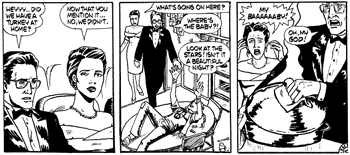![[Metroactive Books]](/books/gifs/books468.gif)
![[Metroactive Books]](/books/gifs/books468.gif)
[ Books Index | Metro | Metroactive Central | Archives ]
Walking Tall Tales
 Dinner Is Served: Pia Guerra's cartoon climax to the infamous urban legend of the hippie babysitter. Urban legends get the cartoon treatment in the 'Big Book' series SOMEWHERE OUT THERE in the hinterlands are bullshit artists who work in the same conditions as the great unknowns of art history. These artisans, toiling in Nebraska or the like, filling gas tanks and waiting tables, are like the anonymous little fellows who built the cathedral at Chartres. Consider, for example, the urban legend of "AIDS Mary," made up out of whole cloth by some unknown master. It's familiar, but let's rephrase. There's a good Christian family man on the road in a strange town; call him "Doug." Doug has too many drinks and picks up a girl. They have a night of conscienceless, unsafe sex. When Doug wakes up, remorseful, she's gone, but the vindictive trollop has left these words scrawled in lipstick on the bathroom mirror: "Welcome to the AIDS club." Good Lord! (Choke!) Any health-care officials can correct me if I'm wrong, but the statistical chance of sexual transmission of HIV from female to male in a one-night stand isn't so high, is it? (Maybe they also shared spikes during that wild night, but the tale-teller forgot to mention it.) The Big Book of Urban Legends (Paradox Press/DC, $12.95) is the first of Paradox Press' The Big Book of ... series. It is an anthology of one-page cartoon versions of many other unverifiable but sworn-as-true stories. The tales are introduced by Jan Harold Brunvand, the Indiana professor who has published several collections of "FOF" (friend of a friend) tales. Here again are the nightmarish legends of the acid-addled hippie baby-sitter ("Everything's fine! She even said that she stuffed and cooked the turkey for us!" "Hey ... did we have a turkey at home?" "Now that you mention it ... no, we didn't."); the old lady who phoned her vet about her choking Doberman; and the unwise consumer who bought a pet on the wrong side of the border ("That ain't no Chihuahua, lady. That's a Tijuana sewer rat!"). Despite the recent Time magazine cover story on how we as a nation are all feeling good (unimpeachable evidence, that), the persistence of these urban legends shows us a country as besieged by fear of ghosts, murderers, demons and foreigners as we were in the days of the Pilgrims. Translating these urban legends to the comic format makes the stories merrier. Maybe retelling them in a medium known for wild fiction and fantasy boils the last grain of truth out of them. The grisly payoffs have the same effect as the punch lines in the old EC horror comics: a triform combination of moral uplift, shock and gross humor. Conscious of the connection to EC, many of the Urban Legends artists finish on an inside joke, using and reusing that familiar Tales From the Crypt climax: "Good Lord! (Choke!)" The Big Book of ... series is being continued in other volumes on such tasty true-life subjects as "Losers," "Thugs," "Martyrs," "Conspiracies," "Death," "Freaks," "Little Criminals" and "Weirdos." I sampled one new volume, The Big Book of Hoaxes ($14.95). As always, the format is inexpensive, and you certainly get a lot more reading for the buck. The dozens of cartoonists used in The Big Book of Hoaxes represent a blend of younger stars and old pros. The Book of Hoaxes collects elder statesman Sergio Aragones of Mad Magazine and young Jason Lutes (Jar of Fools), the latter illustrating the story of the lovely 19th-century fraud Princess Caraboo. Gahan Wilson, drawing with a leisurely pen that demonstrates his great authority as a cartoonist, retells the story of David Rorvik, author of the spurious true story "The Cloning of a Man." It's common to hear how television has destroyed the oral storytelling tradition, but these anthologies seem to prove otherwise. The ostensibly true stories in The Big Book of Hoaxes and The Big Book of Urban Legends demonstrate that the talent for creative delusion--for cooking up a preposterous story--isn't lost. At best, these tales are an example of a dying craft: folk artists creating their own whoppers in a time when the word only makes people think of what they can get for 99 cents at Burger King. On the other hand, the quality of this ambitious lying fades when confronted by an unkillable fraud that's been responsible for genocide, namely "The Protocols of the Learned Elders of Zion," illustrated in The Big Book of Hoaxes by Tom Sutton. The telling and retelling of the Big Lie gave it such authority that otherwise sharp characters from Henry Ford to Louis Farrakhan have been suckered by the Protocols ever since. Still, let's be optimistic; maybe the low-level hoax opposes the high-level hoax. Even Benjamin Franklin, father of American journalism, deliberately printed bullshit stories by the score--perhaps as a way of reminding posterity to not always trust the trustworthy? [ Metro | Metroactive Central | Archives ]
| ||||||||||||||||||||||||||||||
Copyright © Metro Publishing Inc. Maintained by Boulevards New Media.